Etablissement Hydromineral
From Kaletzki, Charles Hirsch. Official history USA Base Hospital No. 31 of Youngstown, Ohio: And Unit G of Syracuse University. Syracuse, NY, Craftsman Press, 1919, pp. 51-52.
The American Red Cross having leased from the Societe des Eaux, the Etablissement Hydromineral, the two base hospitals in this center acquired exceptionally fine bathing facilities, the bath house being one of the most modern and thoroughly equipped of its kind in France. It compares favorably with the better medicinal bathing places in the United States. The opening of the bath house at this time [May 2, 1918] was occasioned by the arrival of the first trainload of patients for Base Hospital No. 31. The convoy included 173 enlisted men, of which only twenty-six were Americans, others being French. The majority of cases were medical, preponderately gas. Hospital Ward No. 4, Hotel Continental, was put into service for the first time, for the accommodation of allied medical cases.
The work of receiving this convoy was greatly facilitated by the use of the bath house, a two story circular building, of brick and stucco construction, with an entrance to the colonnade. The elaborate furnishings used in the peace time operation had been removed from the entrance, from which there were stairways to the second floor and doors opening to the circular hallways which led to the rows of bath rooms. On the main floor were twenty-nine bath rooms, arranged in four series, two of which were considered "first class" compartments, the remainder being smaller rooms with copper tubs. In the first class suites there were two rooms, one of which contained a luxurious porcelain tub of exceptional proportions. On the second floor were twenty-seven bath rooms, most of which were equipped with porcelain tubs.
In addition to the ordinary tub baths there were a number of rooms equipped for the special treatments followed in the prosecution of the health cure here during peace times. All of these had been turned over to the use of the hospitals. In the special bath rooms there were facilities for meccano-therapy, hydrotherapy, light and vapor baths and a complete X-Ray outfit. The last was taken over by the X-Ray department of the hospital to be operated in conjunction with the regular laboratory in rush periods. Two rooms were especially adapted for use in giving sulphur baths. Boiler facilities assured a plentiful supply of hot water at all times.
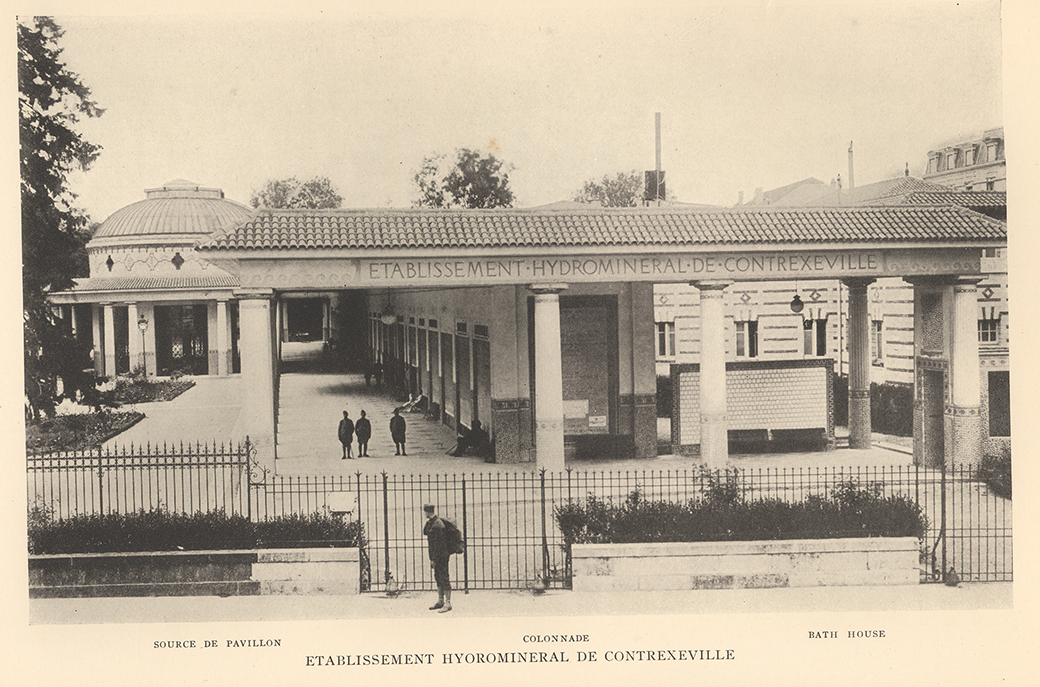
Etablissement Hydromineral de Contrexeville (image from the unit history of Base Hospital 32)
Perhaps the greatest of all blessings brought to the American soldier was the bath house, which was in operation on the arrival of the first convoy of patients for Base Hospital No. 31, on May 2, 1918. To the casual onlooker who watched the long lines of wounded and sick American soldiers filing into the bath house-their faces drawn and frequently besmirched with blood or smeared with dirt, there was a most pathetic sight. Those boys had put every last lick they had into the fight from which they had come only because they were physically incapable of more. What a change there was, when a few minutes later, perhaps even before the last of the line had passed into the bath house, there appeared the first-divested of all material substances with which they had entered, except perhaps a few trinkets--or a picture of a mother or best girl; with clean face, cleansed body and revivified heart, a new pair of pajamas, a real bath robe, a pair of slippers-and a nice cozy, warm blanket thrown over all. There was a change in appearance but it was as naught compared with the inner metamorphosis. Much of the battle of curing that boy was won in the bath house, when, together with all the dirt he brought, was washed away the discouragement that came with death dealing fighting. Combine with the pleasure of that first bath in weeks-or maybe longer-a good puff at a cigarette, handed out and lighted by the same Red Cross girl who brought a cup of steaming hot coffee, and there is immediately a new state of mind. The grouch smiled and the little fellows who hadn't been away from home and mother for very long almost wept for the joy of it all.
[Kaletzki, p. 215]
More than anything else, however, the bath house was the institution universally enjoyed. An evidence of how much it was used is seen in the figures which show that during the six months ending October 30, 1918, there were 30,913 baths taken. The bath house was closed during a short period in November for the installation of nine shower baths, and from then on it was impossible to compute accurately the number of baths furnished. An estimate showed an average of 150 each day up to the time the hospitals were closed. The Red Cross furnished coal, towels and soap. Labor was furnished by the Army. Base Hospital No. 31 was charged with the operation, Sgt. Frank W. Sheppard being in charge. He was assisted by Pvt. lc Arthur Mulvihill and Pvt. Arthur Nostrant as engineers.
[Kaletzki, p. 217]
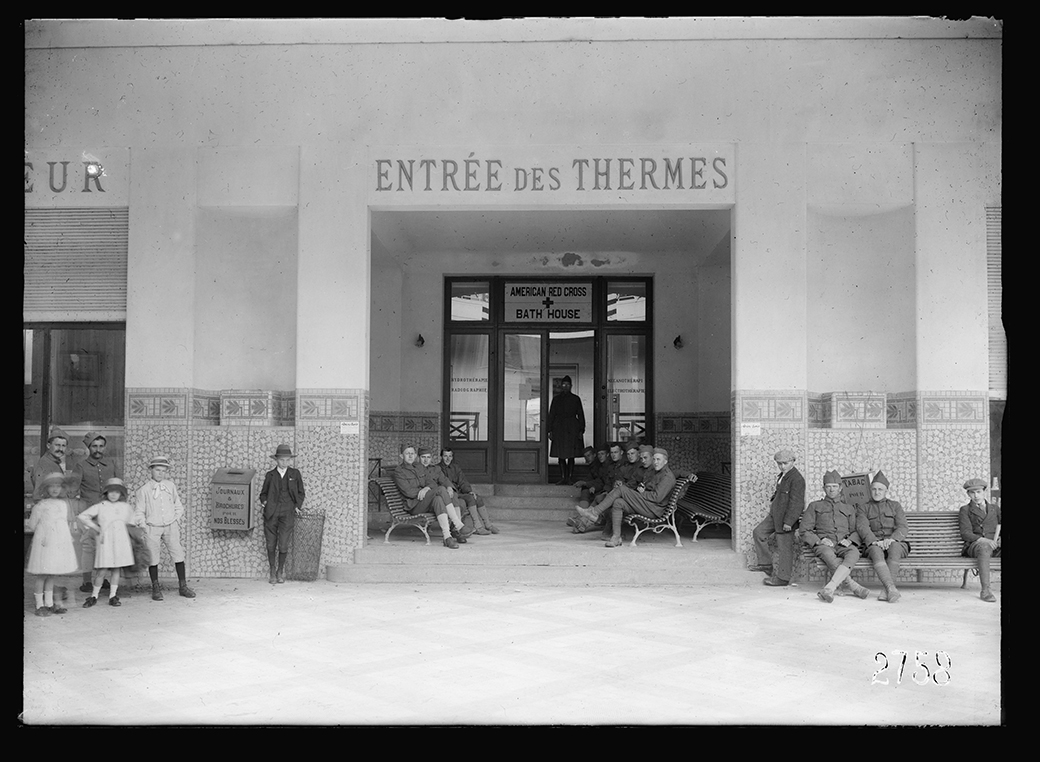
Photo by Lewis Wickes Hine, from the US Library of Congress Digital Collection. Caption provided by the photographer: "Waiting for a Bath. The word "bath" is not in the dictionary as far as the men in the trenches go, so when they get back en repos for a few days they are glad to wait in line for a long time to get one. This picture shows the front of the famous bath house at Contrexeville has been taken over by the American Red Cross for the use of our boys. June 1918"
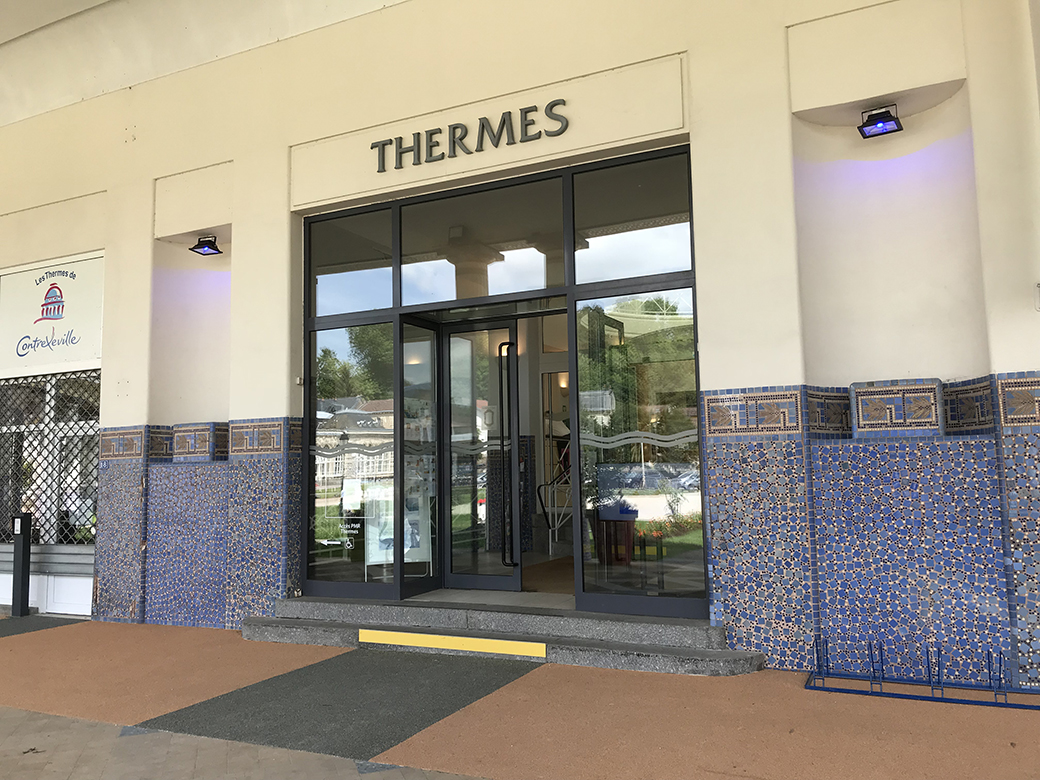
Photo by Molly Daniel, May 31, 2018.
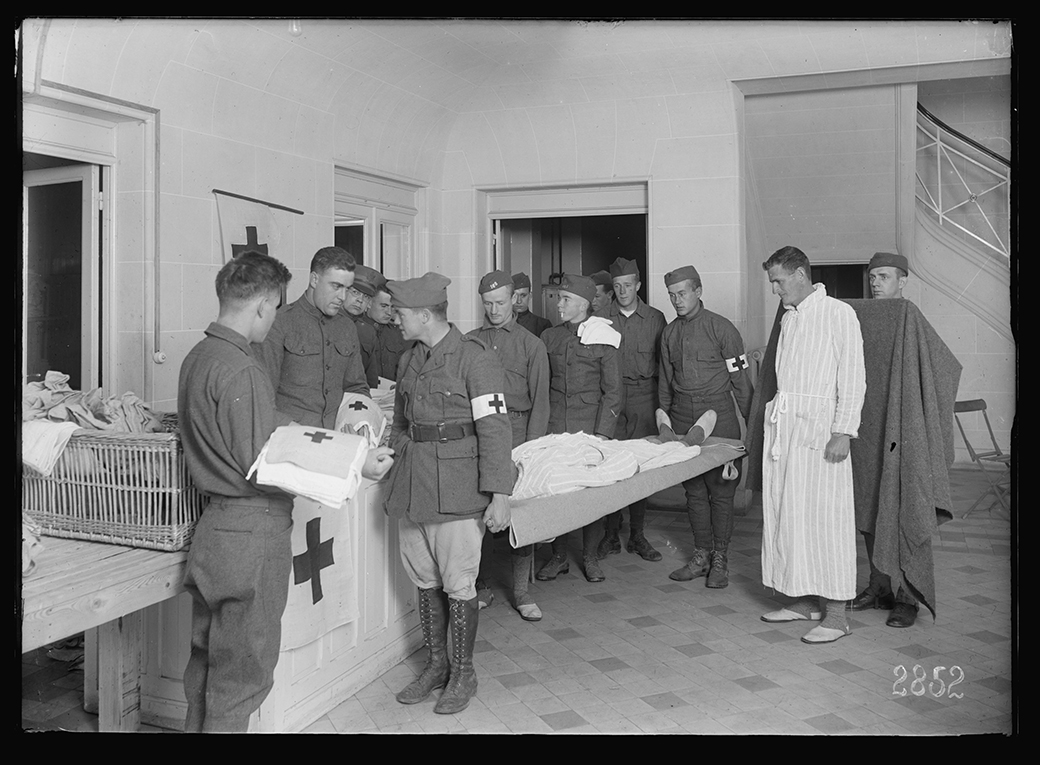
Photo by Lewis Wickes Hine, US Library of Congress. Image created June 24, 1918. Caption provided by photographer: "Wounded man (on stretcher) and others just arrived going to their baths in Contrexeville bath house in June 1918. Over 4000 baths were given convalescent soldiers recently arrived from the front".

Photo by Molly Daniel, baths at Contrexeville, May 31, 2018.
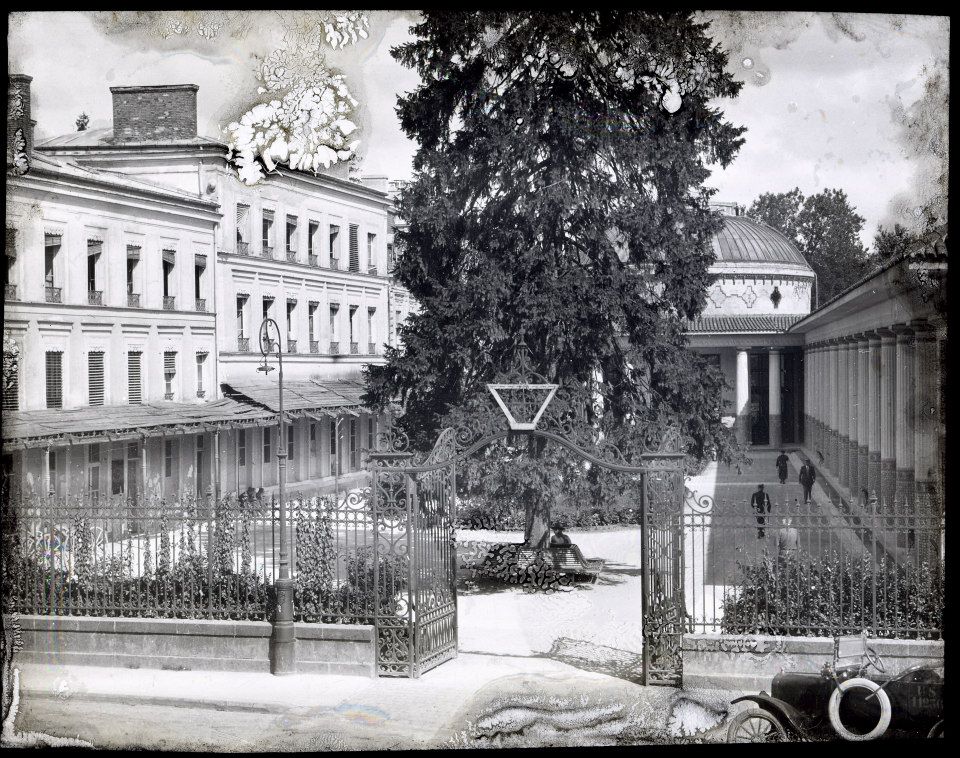
Hotel L'Etablissement (left) and entrance to the Etablissement Hydromineral with the Colonnade on the right. (from the Mahoning Valley Historical Society, Youngstown, OH) The glass plates of the images were damaged, resulting in blemishes on the printed photo.
Postcard image of the interior of the pavilion for the springs at Contrexeville (image from the personal collection of Olive Graber, BH 32 nurse, in the collections of the Iowa Historical Society.)
Sculptures in the pavilion at Contrexeville (image from the personal collection of Olive Graber, BH 32 nurse, in the collections of the Iowa Historical Society.)

The website editor and her sisters, great nieces of Agnes Swift, visit Contrexeville on May 31, 2018. (photo by Molly Daniel)
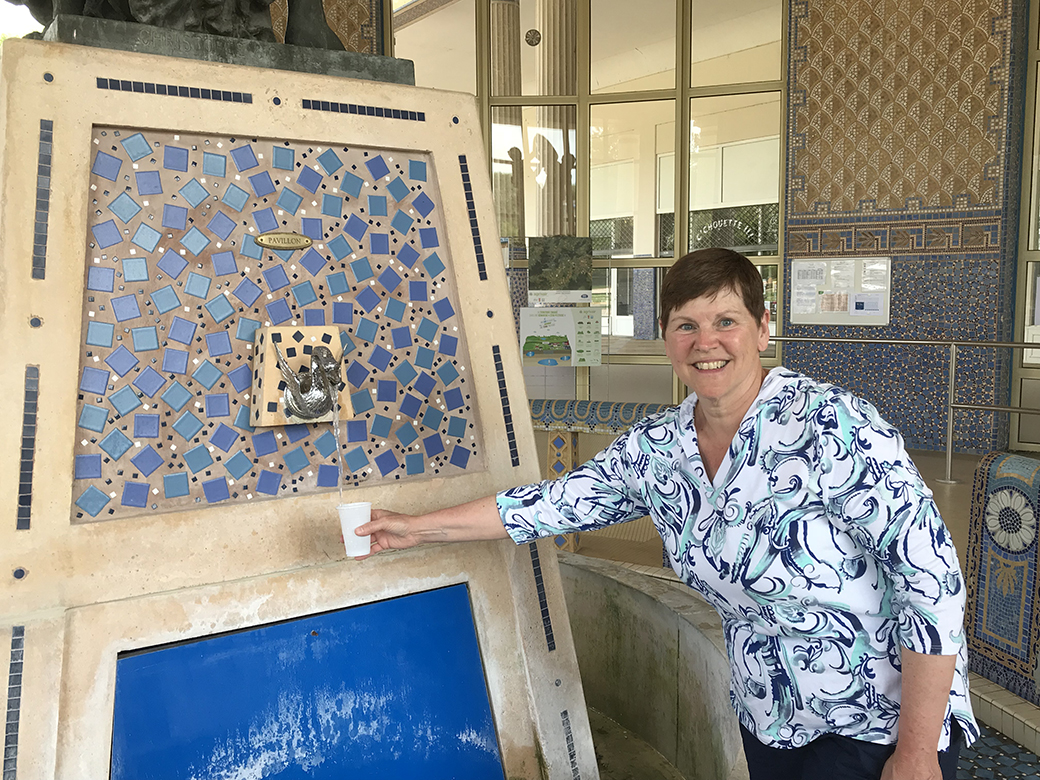
Molly Daniel, sampling the waters at Contrexeville (photo by Molly Daniel, 5/31/2018.)